Bicycles have come a long way since their inception. Over many iterations of drastically different designs we seem to have finally settled on a design. The same can be said for the materials of said bikes.
There are a lot of different materials used in the creation of the various bike parts from plastic pegs or pedals to rubber and obviously a lot of metal. Since the frame is the figurehead of a bike we’re going to concentrate on bike frame materials in this post. Another reason is the variety of materials used to create bike frames in the 21st century.
You might be here for help with deciding which frame material to look out for when purchasing new products. This isn’t an easy answer at all. If I gave the recommendations of a road bike to a BMX biker then they’d have an unfortunate time and probably wouldn’t even find a product with the right materials.
History of Bike Frames and Materials
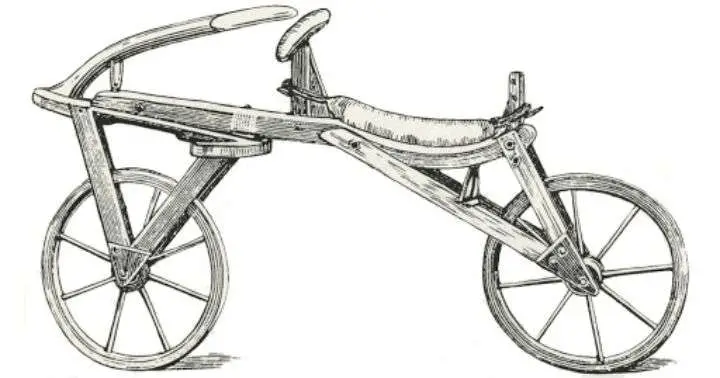
Bicycles first became popularised and developed in the early 1800s. These first bikes were very basic and made from the easiest materials at the time; wood and iron.
Frames didn’t start anywhere near the shape they have today. Karl von Drais, an early bicycle inventor, created a machine he named the ‘Swiftwalker’. This design was pretty much the same as the balance bikes toddlers use today.
A wooden beam attached to wooden wheels that were wrapped with iron and leather for tires. This device wasn’t so much a bicycle as it was a balance bike for adults that allowed people to travel down hills faster than they could walk.
Swiftwalkers weren’t very popular in the subsequent years after its inception. New York event went so far as to ban the device from being used in public and on sidewalks.
It took a lot longer than you’d imagine for the pedals to be attached. I imagine this will have been because of the steep learning curve to successfully ride a bike without their feet on the floor.
From then on each part was gradually improved upon until we reached the product we have today. Pneumatic tires were a huge improvement when they were successfully implemented in 1888. Riders claimed they felt every bump when riding bikes with wooden wheels and iron tires.
As the early 1900s came around most frames were made from steel tubing. As you can imagine these bikes couldn’t be described as light. It wasn’t uncommon for bikes of this era to be over 35kg. I’m not sure if they would’ve been throwing them around over dirt jumps like we do today.
Common Bike Frame Materials
Several different materials are used to create the vast majority of bike frames. Different materials have different advantages and disadvantages, making them more suited to different cycling disciplines. I am going to explore the main materials in this next section and which bikes are best suited to these materials.
Wood

Today we only use wood in special circumstances. There are a few brands making a comeback using wood as their main frame material but they’re a very small subset of the market now.
As I stated above, once upon a time wood was the predominant material in bicycle manufacturing. Granted these were bikes people were making in their workshops but I think it’s important to show how far we’ve come.
Modern technology is used heavily in modern wood frame manufacturing. Dozens of separate pieces of extremely high quality lumber can be used in a single frame. Precise milling and planking machines are used to accurately cut this lumber into the correct shapes for the frame.
The CNC, milling and other machines are great for creating strengthened parts but they’re going to need that extra edge to withstand the extreme conditions we see cyclists enduring around the globe. Layers of epoxy are used for sealing, which is then covered with a multi-layer finish. Clear waterproof sealers and polyurethane mixtures are used to keep the frame from soaking moisture or expanding and changing shape in changing climates.
This development has come a surprisingly long way. Performance wooden bikes are being used throughout the world, at the same level as regular aluminum or carbon fibre bicycles. Wood is notoriously durable, shock absorbent and lightweight. The negative properties of wood are being easily eliminated, giving this material a powerful comeback.
Materia Bikes
Steel Cycling Frames
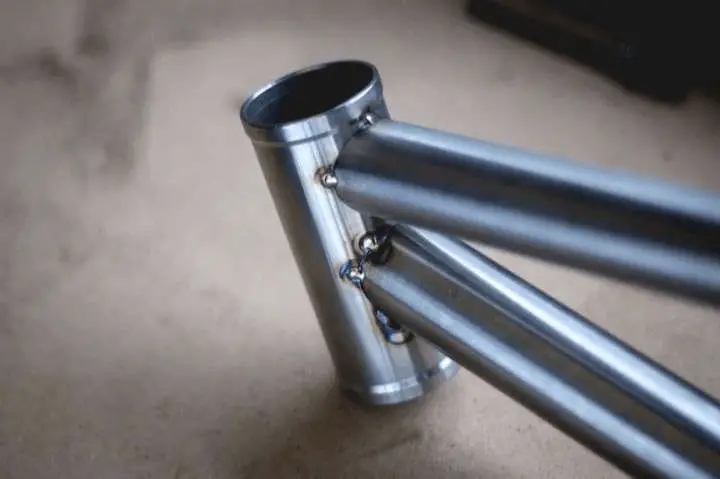
You already know steel is an important material in frame creation. We’ve been working with steel for so long in so many industries that we’ve tuned it in a crazy amount of ways. There’s a vast selection of steel tubing we can pick from that all offer different prospects.
Steel has lots of advantages and disadvantages. The first thing you’ll hear people complain about is the weight. Steel is one of the heaviest metals used to build bikes but there are many other positive aspects that have made it the material of choice for the majority of bicycles in the world.
Strong, hard, stiff, durable and cheap are commonly used adjectives when discussing steel. It can take a beating and spring straight back to its original shape and will never abruptly fail. If your steel frame decides it’s time to die it will slowly and visibly break, keeping you safer.
You may have read above that early 1900s bikes were often well over 30kg. Steel tubing has evolved a lot since then. Mild steel is the name for everything discussed above. This is still what most cost-effective bikes are made of when weight really isn’t a factor.
Since the inception of mild steel we have progressed to high-tensile steel, which is used for commuter bikes where weight still isn’t too important but extra strength is appreciated, and various alloys. We are going to discuss steel alloys in the next section.
Chromoly Steel
Chrome-moly, cromo, chromoly are all names for the same extremely popular material. This form of steel is a type of engineering steel that garnered it’s name from the mix of ‘chromium’ and ‘Molybdenum’. 0.8% – 1.1% molybdenum is used with a medium carbon content for this alloy.
Put simply, chromoly is an upgraded version of steel often used for engineering purposes. It’s lighter, stiffer, more expensive and more brittle than steel while also being heavier, less brittle and cheaper than aluminum.
I see chromoly as a middleman between steel and aluminum. BMX bikes are often made from this alloy as riders are looking for a light bike that can have thin, seamless tubes while being super stiff and strong.
Aluminum Bikes
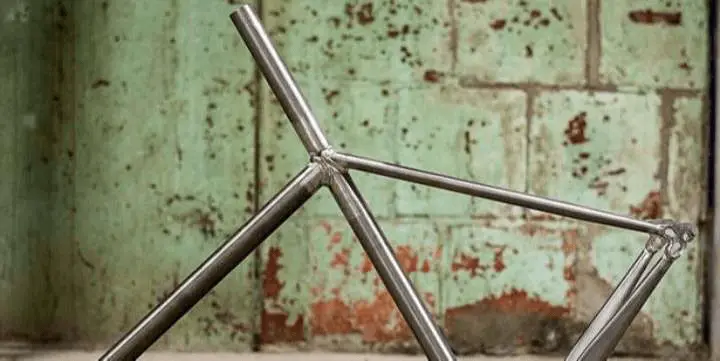
The vast majority of mid range bikes are made from aluminum. Reduced weight and relatively inexpensive price make it perfect for a lot of cycling disciplines. Aluminum is often in competition with steel in the world of bikes. Being about a third as stiff, a third as heavy and more expensive the respective materials are much better suited to different parts and disciplines.
Steel is much stronger and much better at flexing and returning to it’s original shape than aluminum. For something like a road bike which doesn’t have suspension, uses thin tubes and endures various external forces aluminum won’t fare so well.
On the other hand a mountain bike, which has extensive suspension and much thicker tubing can cope quite well with aluminum. The weight difference is great for speed and much of the riding forces are eliminated through the suspension.
Even for mountain bikes it’s quite uncommon for force areas such as suspension to be made from aluminum. Suspension is usually made from steel or chromoly, two materials that can offset some of the riding vibration through the metal flexibility instead of sending it straight to the handlebars.
Titanium
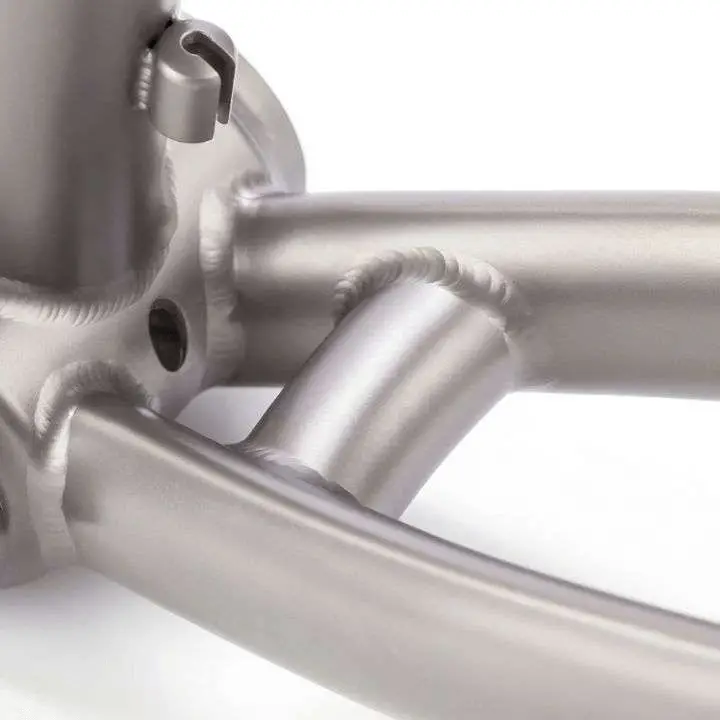
Photo by J.Laverack bikes
Now we come to the top of the range materials. Those reserved for the top athletes and wealthiest riders. Titanium is such an efficient material it’s very often used in aerospace engineering. With the same tensile strength as steel, twice the strength of any aluminum alloy and lighter than all of the above.
Titanium is so expensive it’s effectively a niche term within the world of bikes, even when compared to carbon fibre. This material copes with fatigue and impacts better than most materials and it doesn’t corrode, meaning it can be produced without a brushed finish. A finish such as this isn’t essential for titanium bike frames despite being preferred by many riders.
Road bikes are one of the more popular disciplines to use Titanium. Aluminum and vanadium are typically alloyed with titanium in various proportions to improve the durability and other properties over the pure material.
Titanium can be cold drawn and hydroformed, similarly to aluminum. These techniques can create various shaped tubesets with external or internal cable routing. It is difficult to weld titanium alloys as it reacts with oxygen. These welds often take over 5 hours of labour, further increasing the price.
Carbon Fibre
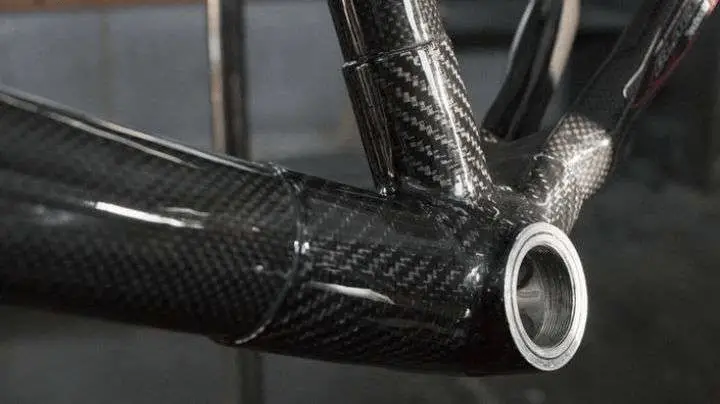
As carbon fibre has become more affordable, its applications are becoming more widespread. Carbon fibre has come a long way from its initial applications in top of the range road bikes.
Nothing on this list beats the strength to weight ratio of composite carbon fibre. Unfortunately it’s still more expensive than most steel or aluminum parts. Along with the price, impact damage is probably the part hardest to justify. If you’re looking into a carbon fibre bike you need to really think about the type of riding you’ll be doing, at what level and the feasibility of repairing or replacing expensive bike parts.
Creating items with carbon fibre is much more interesting than regular metals. Instead of alloying with different amounts of similar metals or thickening some sections of tubing you can simply change the direction of fabric, thus altering the dispersal of forces acting upon that area.
It’s important to buy carbon fibre bikes from reputable manufacturers as when it fails it fails fast. You don’t get slightly bent or cracked carbon fibre as you do aluminum or steel. Many manufacturers add more fibre sheets than is necessary to prevent such breakages.
Road and cyclocross bikes are by far the most popular use of carbon fibre today. Weight, aerodynamics and stiffness are super important for riders of this discipline. The weight reduction over any metal is tremendous, even when an excess amount of fabric is used.
It’s relatively well known that road cycling doesn’t involve many hard knocks or large jumps like mountain biking does. This helps manufacturers dedicate materials to specific places, protecting them from the common forces of road cycling.
Mountain bikers encounter so many unexpected knocks, jumps and forces it’s hard to protect against them all. Suspension and other larger bike parts add extra weight to mountain bikes, reducing the effectiveness of carbon fibre on MTB.


